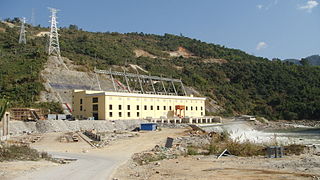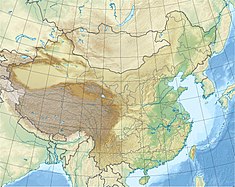
Nuozhadu Dam is an embankment dam on the Lancang (Mekong) River in Yunnan Province in southwest China. The dam is 261.5 m (858 ft) tall, and creates a reservoir with a normal capacity of 21,749,000,000 m3 (17,632,000 acre⋅ft) at a level of 812 m (2,664 ft) asl. The purpose of the dam is hydroelectric power production along with flood control and navigation. The dam supports a power station with nine generators, each with generating capacity of 650 MW. The total generating capacity of the power station is 5,850 MW. Construction on the project began in 2004; the dam's first generator went online 6 September 2012 and the last generator was commissioned in June 2014. The construction and management of the project was implemented by Huaneng Power International Ltd., which has a concession to build, own and operate hydroelectric dams on China's stretch of the Mekong River.
The Xiaowan Dam is an arch dam on the Lancang (Mekong) River in Nanjian County, Yunnan Province in southwest China. The primary purpose of the dam is hydroelectric power generation and it supports a 4,200 MW power station. Constructed between 2002 and 2010 by Huaneng Power International at a cost of ¥32 billion, it is the world's second highest arch dam at 292 m (958 ft). It is also third highest among dams of all types behind Jinping-I and Nurek and the third largest hydroelectric power station in China.
The Goupitan Dam is an arch dam on the Wu River, a tributary of the Yangtze River in Guizhou Province, southwest of China. The dam's hydroelectric facility will operate on five turbines, each with a hydroelectric generating capacity of 600 MW, for a total of 3,000 MW. Constructions began on in 2003 and the first generator was operational in June 2009. All works were completed in 2011.

The Wudongde Dam is a large hydroelectric dam on the Jinsha River, an upper stretch of Yangtze River in Sichuan and Yunnan provinces in southwest China.
The Manwan Dam is a large hydroelectric dam in China. It is built on the Mekong (Lancang) River with a capacity of 1,570 MW.
The Jinghong Dam is a gravity dam composed of roller-compacted concrete on the Lancang (Mekong) River near Jinghong in Yunnan Province, China. The main purpose of the dam is hydroelectric power production and it has an associated 1,750 MW power station. Part of the power generated is sold to Thailand under an agreement with China.

The Shweli I Dam is a gravity dam on the Shweli River about 23 kilometres (14 mi) southwest of Namhkam in Shan State, Burma. The primary purpose of the dam is hydroelectric power generation and it supports a 600 megawatts (800,000 hp) power station. Water from the dam's reservoir is diverted through a 5.1 kilometres (3.2 mi) long headrace tunnel to the power station downstream. The drop in elevation affords a hydraulic head of 299 metres (981 ft). Construction on the dam began in 2002 and the river was diverted on 10 December 2006. On 5 September 2008, the first generator was commissioned and the last of the six was commissioned in April 2009. The dam and the power station were constructed under the build–operate–transfer method and cost US$756.2 million. It is owned and operated by the Shweli River-I Power Station Co. The Shweli II and Shweli III Dams are planned downstream.

The Huangdeng Dam is a gravity dam recently completed on the Lancang (Mekong) River in Lanping Bai and Pumi Autonomous County of Yunnan Province, China. The fact that work on the dam was begun without formal approval from the central government was a subject of some controversy.
The Miaowei Dam is a rock-filled embankment dam on the Lancang (Mekong) River in Yunlong County of Yunnan Province, China. Construction on the dam began in 2010. The four turbines of 1,400 MW hydroelectric power station were commissioned in 2017 and 2018.
The Lizhou Dam is a run-of-the-river hydroelectric arch dam on the Muli River in Muli Tibetan Autonomous County, Sichuan Province, China.
The Wunonglong Dam is a gravity dam situated on the Lancang (Mekong) River in Weixi Lisu Autonomous County, Yunnan of Yunnan Province, China. The primary purpose of the dam is hydroelectric power production. Construction on the dam began in 2010 and the river was diverted around the foundation in November 2014. In 2016, construction began on the main dam, which was subsequently completed in 2017. By July 2019, all four hydroelectric generators were operational and the power station was operating at its full capacity of 990 MW.
The Gongguoqiao Dam is a gravity dam on the Lancang (Mekong) River in Yunlong County of Yunnan Province, China. The primary purpose of the dam is hydroelectric power generation. Construction began in 2008, and the river was diverted around the dam site in 2009. The next year concrete placement began, and in 2011 the first generator was commissioned. The 900 MW power station was fully operational on 21 June 2012.
The Yinpan Dam is a gravity dam on the Wu River in Wulong County of Chongqing Municipality, China. The primary purpose of the dam is hydroelectric power production and navigation. It supports a 500-ton ship lift and a 600 MW power station. Construction on the project began in 2005 and it was completed in 2011 with the first generator commissioned in May of the same year, the fourth in December.
The Maoergai Dam is a rock-filled embankment dam on the Heishui River in Mao County of Sichuan Province, China. The primary purpose of the dam is hydroelectric power production and it supports a 420 MW power station. Preliminary construction for the dam began in 2006 while construction on the dam and power station commenced in 2008. The generators were commissioned in 2011. To produce power, water from the reservoir is diverted to a power station downstream through a 16.15 km (10.04 mi) long headrace tunnel and penstock. The difference in elevation between the reservoir and power station affords a hydraulic head of 168 m (551 ft). The dam sits just below the headwaters of the Heishui and water discharged through its power station regulates the flow of water for smaller power stations downstream.
The Longjiang Dam is an arch dam on the Long River near Mangshi in Dehong Prefecture of Yunnan Province, China. It is a multiple-purpose project aimed at flood control, irrigation and hydroelectric power generation. Its reservoir has a storage capacity of 1,217,000,000 m3 (986,638 acre⋅ft), of which 679,000,000 m3 (550,474 acre⋅ft) is reserved for river these purposes. The dam's power station is located on its left bank and contains three 80 MW Francis turbine-generators for a total installed capacity if 240 MW. Construction on the project began on 28 November 2006 and all generators were commissioned in 2010.

Hydroelectricity is currently China's largest renewable energy source and the second overall after coal. According to the International Hydropower Association, China is the worlds largest producer of hydroelectricity as of 2021. China's installed hydroelectric capacity in 2021 was 390.9 GW, including 36.4 GW of pumped storage hydroelectricity capacity, up from 233 GW in 2011. That year, hydropower generated 1,300 TWh of power, an increase of 68 TWh over 2018 when hydropower generated 1,232 TWh of power, accounting for roughly 18% of China's total electricity generation.





